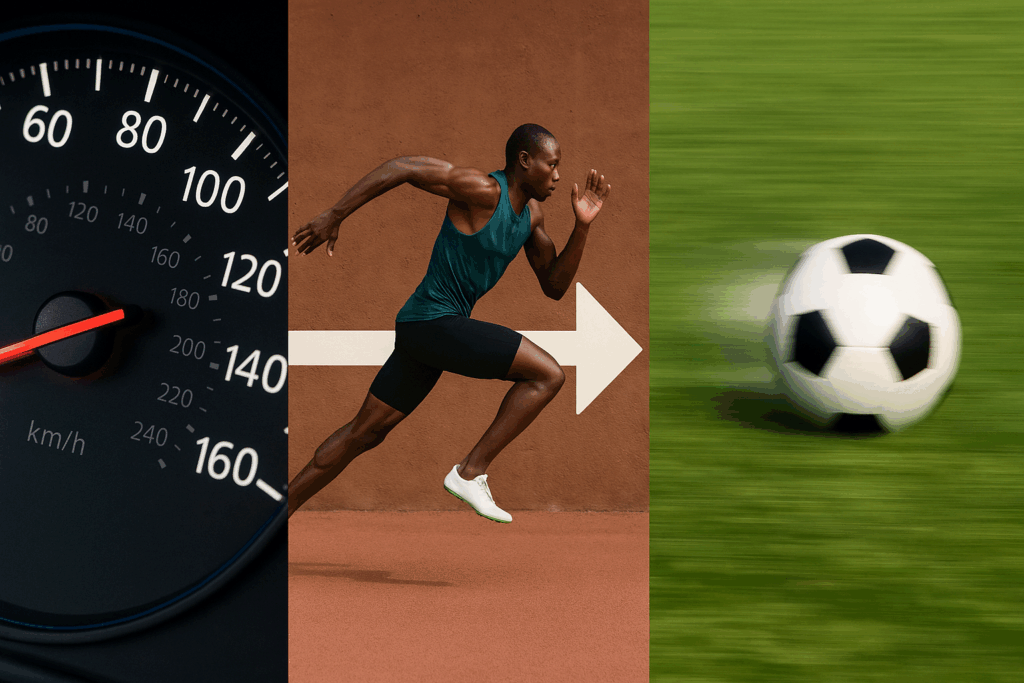Have you ever raced your friends in the playground, watched an okada zip through traffic, or noticed how a bus slows down to pick up passengers? All these everyday events can be explained using three important science ideas: speed, velocity, and acceleration.
These concepts are not as hard as they sound. In fact, once you see their differences, similarities, and real-life uses, you’ll realise they are part of your daily life.
What is Speed?
Speed simply means how fast something is moving. It tells us the rate at which an object covers distance, but does not say anything about direction.
Example:
- If you run 100 metres in 20 seconds, your speed is 5 metres per second (m/s).
- A car moving at 60 km/h on the expressway has a speed of 60 km/h, whether it is going east, west, north, or south.
Safe Practical:
Take a stopwatch and measure how long it takes you to walk from your bedroom to the front door. Divide the distance by the time; it gives your walking speed.
What is Velocity?
Velocity is speed with direction. It tells us not just how fast you are moving but also where you are going.
Example:
- If that same car is moving 60 km/h north, then we are talking about velocity, not just speed.
- A football kicked towards the goalpost has a velocity because it has both speed and direction.
Safe Practical:
Throw a small ball across your school field. Watch how it moves in a straight line. Now say out loud: “The ball’s velocity is towards the goalpost at ___ metres per second.”
What is Acceleration?
Acceleration is how fast the velocity changes. It could mean speeding up, slowing down, or changing direction.
Example:
- When a motorcycle starts from rest and reaches 20 km/h in a few seconds, it is accelerating.
- When a bus slows down at a bus stop, it is experiencing negative acceleration (also called deceleration).
Safe Practical:
On your next bicycle ride, notice how it feels when you start pedalling harder. That “push” that makes you go faster is acceleration.
Watch how speed, velocity, and acceleration work!

Speed, Velocity, and Acceleration: Differences and Similarities
- How are they similar? All three are about motion (how things move).
- How are they different?
- Speed = how fast.
- Velocity = how fast + in which direction.
- Acceleration = how the velocity changes.
- Speed = how fast.
Understanding speed, velocity, and acceleration helps us describe motion more accurately and predict how objects will behave.
Newton’s Laws and Motion
Now, Sir Isaac Newton gave us three simple laws that connect directly to speed, velocity, and acceleration.
- First Law (Inertia): This states that things stay at rest or keep moving in a straight line at constant speed unless a force acts on them.
- Example: A football won’t roll unless you kick it.
- Example: A football won’t roll unless you kick it.
- Second Law: Force equals mass times acceleration (F = Mass x Acceleration).
- Example: Pushing a school desk is easier than pushing a teacher’s heavy table. The heavier the object, the more force you need.
- Example: Pushing a school desk is easier than pushing a teacher’s heavy table. The heavier the object, the more force you need.
- Third Law: For every action, there is an equal and opposite reaction.
- Example: When you jump off the ground, the ground pushes you up as you push it down.
- Example: When you jump off the ground, the ground pushes you up as you push it down.
These laws explain why speed, velocity, and acceleration matter in the first place. They show us that motion only changes when a force is applied.
Why is Studying Speed, Velocity, and Acceleration Important?
- In sports: Footballers and sprinters use them all the time.
- Footballers use it to run faster, turn quickly, and get past other players.
- Sprinters use it to start fast and keep running at top speed for short races.
The difference between a fast runner and a slower one is speed and acceleration.
- In transport: Car makers design vehicles by studying how quickly they can accelerate and stop safely.
- In daily life: Crossing the road safely depends on estimating the speed and velocity of incoming vehicles.
When you understand speed, velocity, and acceleration, you begin to see the world differently. You can predict motion, stay safer, and even perform better in science and mathematics.
These concepts don’t stand alone. They connect directly to other big science ideas such as force, motion, work, and energy. To dive deeper, check out this related post: Understanding Force, Motion, Work and Energy.
For more expert insights into Newton’s laws of motion, you can also visit NASA’s Beginner’s Guide to Motion.
Explore More Exciting STEM Concepts
From racing with friends to watching vehicles move on the road, speed, velocity, and acceleration are everywhere around us. They may sound like tough science terms, but they are really just ways of describing how things move. And with Newton’s laws, we know the rules that govern these movements.
Want to explore more exciting STEM concepts in a simple and fun way? Download the uLesson app today or use the web version and start learning with interactive lessons, videos, and quizzes designed just for you!



